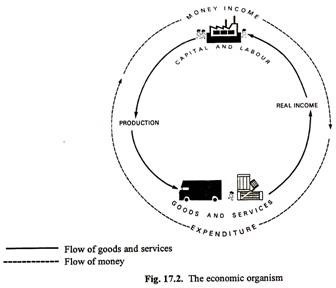Let us make an in-depth study of the subject-matter, concept and definition of national income.
National Income # Meaning:
Economic development of any country is measured by the growth in national and per capita income. In other words, national income is the yardstick of measuring the growth performance of any economy.
An increase in national income implies economic growth. In view of this, every country prepares statistics on national income as well as its various aspects.
The method through which national income statistics is prepared and compiled is called national accounting. Thus, national income accounts can be defined as a set of systematic statistical statements which reflect the aggregate money value of all goods and services produced in the different sectors of the economy (e.g., primary, secondary and tertiary sectors) together with the records of distribution of factor incomes among different groups and final expenditure (either gross or net) of the economy.
ADVERTISEMENTS:
In national income accounts, all types of transactions conducted, say, in a year, are recorded. These are systematically classified and entered into national income accounts by the statisticians. Thus, national income accounts reflect how millions of transactions that are conducted are interrelated.
National Income # Definitions:
The working of an economy is usually conducted in monetary terms, i.e., in terms of money costs and prices. Fig. 17.2 illustrates the general relationship between these physical and monetary outlooks. The inner arrow relate to the use of factors of production to provide those goods and services which constitute a community’s real income. The standard of living of a country depends on this. The outer arrows indicate the more familiar cycle of money.
In return for their contributions to production the owners of factors (such as labourers, landlords, moneylenders and organisers) receive money income which is then utilised to purchase various goods and services to satisfy wants.
ADVERTISEMENTS:
Thus:
Real income = the flow of goods and services produced
Money income = the flow of money received for productive activity.
The real income of a community thus, consists of the flow of goods and services and money, acting as a unit account, is used as a measuring rod of this flow. The monetary values of goods and services are determined by the amount spent on them and the total amount spent by a community depends on its money income. There is, thus, a circular flow of money within an economy, as Fig. 17.2 indicates. People earn money by producing goods and services and then spend the money on buying goods and services to satisfy their wants.
National Income # Three Concepts:
ADVERTISEMENTS:
In any discussion of national income and national products three terms are used interchangeably — national income, national product and national expenditure. In any nation, the sum of the incomes earned by its citizens during any given period of time, usually one year, is called national income.
From another angle it is the monetary value of the goods and services produced in an economy over a particular period of time (usually a year). The total value of all goods and services produced in an economy during any given period is called national product. The amount spent by a nation in buying goods and services during any given period is called national expenditure (outlay).
These three concepts are three viewpoints of the same circular flow of purchasing power, i.e., of money used to facilitate the exchange of goods and services. These three concepts are just different views of the same thing.
This can be expressed by a statement of identity:
National Income Ξ National Product Ξ National Expenditure.
